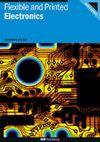Feasibility of conductive embroidered threads for I2C sensors in microcontroller-based wearable electronics
IF 3.2
4区 工程技术
Q3 MATERIALS SCIENCE, MULTIDISCIPLINARY
引用次数: 1
Abstract
In recent years, the importance of flexible and textile electronics in the field of wearable devices has continuously increased, as they are expected to replace conventional wires that exhibit limited resistance to the mechanical stress occurring in on-body applications. Wearable health devices (WHDs) can provide physiological information about various body parts and employ distributed sensor networks. Among the sensors typically integrated within WHDs, those based on the I2C communication protocol are very common and exploit signals transmitted at frequencies up to hundreds of kilohertz. Therefore, robust communication is required to guarantee a proper transmission of the signal at those frequencies. In this context, we have realized embroidered conductive threads exhibiting a lower resistance, appositely designed to replace conventional wires in a microcontroller-based wearable device employing I2C sensors. A commercial conductive thread (silver coated polyamide) was used to embroider the conductive lines on to cotton fabric. Preliminary measurements were performed to characterize the response of these materials to signals typically operated within the I2C communication protocol at different path lengths. Resistive measurements have also been performed to stimulate different environmental conditions, that is, temperature, the effect of sweating, and repeated washing cycles, also apply mechanical stress, i.e. twisting, with promising results that validate our conductive paths for digital signal communication.基于微控制器的可穿戴电子产品中I2C传感器的导电绣花线的可行性
近年来,柔性和纺织电子产品在可穿戴设备领域的重要性不断增加,因为它们有望取代对身体应用中出现的机械应力表现出有限抵抗力的传统电线。可穿戴健康设备(WHD)可以提供关于各种身体部位的生理信息,并采用分布式传感器网络。在通常集成在WHD内的传感器中,基于I2C通信协议的传感器非常常见,并利用高达数百千赫的频率传输的信号。因此,需要稳健的通信来保证信号在这些频率下的正确传输。在这种情况下,我们已经实现了具有较低电阻的刺绣导电线,该导电线被恰当地设计为在使用I2C传感器的基于微控制器的可穿戴设备中取代传统电线。使用商业导线(镀银聚酰胺)将导线绣在棉布上。进行了初步测量,以表征这些材料对通常在I2C通信协议内以不同路径长度操作的信号的响应。还进行了电阻测量,以刺激不同的环境条件,即温度、出汗的影响和重复的洗涤循环,也施加了机械应力,即扭曲,结果很有希望,验证了我们用于数字信号通信的导电路径。
本文章由计算机程序翻译,如有差异,请以英文原文为准。
求助全文
约1分钟内获得全文
求助全文
来源期刊

Flexible and Printed Electronics
MATERIALS SCIENCE, MULTIDISCIPLINARY-
CiteScore
4.80
自引率
9.70%
发文量
101
期刊介绍:
Flexible and Printed Electronics is a multidisciplinary journal publishing cutting edge research articles on electronics that can be either flexible, plastic, stretchable, conformable or printed. Research related to electronic materials, manufacturing techniques, components or systems which meets any one (or more) of the above criteria is suitable for publication in the journal. Subjects included in the journal range from flexible materials and printing techniques, design or modelling of electrical systems and components, advanced fabrication methods and bioelectronics, to the properties of devices and end user applications.
 求助内容:
求助内容: 应助结果提醒方式:
应助结果提醒方式:


